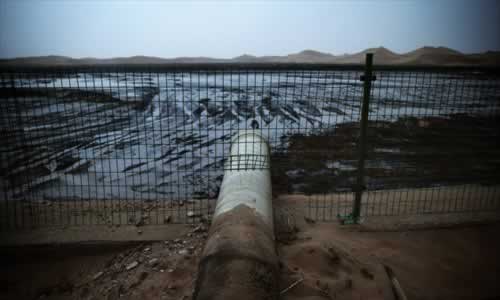导读:近日,国土资源部发布了一份调查结果,显示中国60%以上地下水质”恶劣”或“非常恶劣”。

The Ministry of Land and Resources (MLR) recently released its 2015 survey results, which show that of its more than 5,000 underground water monitoring sites in 202 cities, the water quality at more than 60 percent is "bad" or "very bad."
国土资源部近日发布了其2015年调查结果,在其分布于202个城市的5000多地下水质监测点中,超过60%的监测结果显示水质“恶劣”或“非常恶劣”。
The factors that led many of the sites to be substandard include excessive water hardness and elevated concentrations of manganese and sulfate. At some locations potentially harmful concentrations of arsenic, lead, cadmium and chrome were found in groundwater.
导致许多监测点水质不合格的原因包括过高的水硬度,以及锰和硫酸盐监测结果超标。在某些监测点,地下水中被检测出潜在有害浓度的砷,铅,镉和铬。
Compared with the previous year, water quality at more than 62 percent of the monitoring sites was stable, 17 percent were improving, while 20 percent were worsening, the report said.
这份报告显示,和去年相比,超过62%监测点的水质保持稳定,17%监测点的水质有所提升,20%监测点的水质恶化。
Reports about polluted water resources are always alarming, and different government departments seem to have different responses.
水资源污染报告总是令人担忧,而不同的政府部门对这一事件的反应则有不同。
In early April, a Ministry of Water Resources (MWR) report saying "80 percent of China’s underground water is undrinkable" evoked great public concern.
在四月上旬,水利部一份报告指出“中国80%的地下水不可饮用”,引起了公众极大的关注。
The MWR later claimed that the media had misunderstood its report, which meant to say that 80 percent of the shallow layer of underground water was undrinkable, but the deeper layer of underground water, which is a major source of drinking water, was not that bad.
水利部后来澄清说媒体误读了这份报告,(并解释说)该份报告指出80%的浅层地下水不可饮用,但是作为饮用水主要来源的深层地下水的水质还是不错的。
Among the country’s 4,748 sources of drinking water, 1,817 are underground water sources, and about 85 percent of such sources meet water standards, the ministry said.
水利部表示,在全国4748个饮用水源地中,有1817个是地下水源地,其中有85%的水源地可以达到水质要求。
"In the water pollution report, the MWR looked at 18 provinces and regions in northern China where water pollution is more serious, but the monitored subjects were mainly shallow underground water," said Jia Shaofeng, deputy director of the water resources research center at the Chinese Academy of Sciences. "We are using less underground water for our drinking water now."
中科院水资源研究中心副主任贾少锋说:“在这份水污染报告中,水利部关注了中国北方的18个省市和地区,这些地方的水污染要更严重一些。但是监测的目标主要是浅层地下水。人们现在更少于用地下水做饮用水源了。”
Ma Jun, director of the Institute of Public and Environmental Affairs, said many localities have been digging deeper to collect underground water because the shallow water is too polluted. "But it does not mean we don’t have to worry about the quality of the deeper water," he said, adding that deeper underground water can also get polluted, and the amount of such water is limited.
公共和环境事务研究所所长马军(音)表示,许多地方都已经在挖掘更深的地方来汲取地下水,因为现在浅层地下水已经被污染了。马军说道:“但是这并不意味着我们可以不必担忧深层地下水的水质。”他补充说道,深层地下水同样可以被污染,而且深层地下水的水量是有限的。







